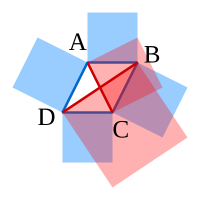Parallelogram law

Okay kiddo, have you ever played with toy cars or balls? Imagine that you have two cars or two balls that you want to move around at the same time. You might wonder how you can move them together in a certain direction, right?
Well, the parallelogram law helps you do just that! It says that if you have two forces (like pushing or pulling), you can combine them together to make a new force that points in a different direction.
To understand this better, let's imagine you have two sticks that you want to slide around in different directions. If you push them in the same direction, they will move forward together. But what if you push them in different directions?
If you push one stick to the right and the other stick up, they might not move in the same direction, right? Well, that's where the parallelogram law comes in.
The parallelogram law tells us that if we visualize the forces as little arrows, we can draw a parallelogram with those arrows and the diagonal of that parallelogram will tell us the direction and size of the combined force.
So, let's do that with our sticks. Draw an arrow to represent the force pushing one stick to the right and another arrow pointing upwards to represent the force pushing the other stick up. Now, draw a parallelogram connecting the two arrows.
The diagonal of that parallelogram will represent the combined force that the sticks experience. It will be pointing somewhere in between the right and up directions, and it's size will depend on how strong the pushing forces were.
So there you have it, the parallelogram law helps us combine forces in different directions to create a new force with a direction and size that we can predict. Pretty cool, huh?
Well, the parallelogram law helps you do just that! It says that if you have two forces (like pushing or pulling), you can combine them together to make a new force that points in a different direction.
To understand this better, let's imagine you have two sticks that you want to slide around in different directions. If you push them in the same direction, they will move forward together. But what if you push them in different directions?
If you push one stick to the right and the other stick up, they might not move in the same direction, right? Well, that's where the parallelogram law comes in.
The parallelogram law tells us that if we visualize the forces as little arrows, we can draw a parallelogram with those arrows and the diagonal of that parallelogram will tell us the direction and size of the combined force.
So, let's do that with our sticks. Draw an arrow to represent the force pushing one stick to the right and another arrow pointing upwards to represent the force pushing the other stick up. Now, draw a parallelogram connecting the two arrows.
The diagonal of that parallelogram will represent the combined force that the sticks experience. It will be pointing somewhere in between the right and up directions, and it's size will depend on how strong the pushing forces were.
So there you have it, the parallelogram law helps us combine forces in different directions to create a new force with a direction and size that we can predict. Pretty cool, huh?
Related topics others have asked about:
